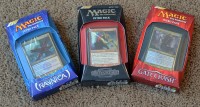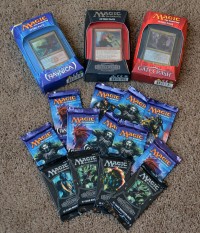
Some Magic: the Gathering starter packs
It?s hard to get around in the gaming world without hearing about Magic: the Gathering. It seems to be everywhere. Board game hobby stores worldwide have weekly Magic: the Gathering nights (or multiple nights). And Magic tournaments are held all over the world as well.
With the extreme popularity of the game, you?d think we would have tried it out by now. However, our family has yet to play Magic.
It?s swirled around us, but we?ve never taken the bait.

More packs of cards ? who knows which cards are inside?
Magic: the Gathering was first published in 1993 and has continued to expand immensely for the past 20 years. It?s estimated that the game has over 17,000 different cards!
It?s definitely the grandaddy of the Collectible Card Game (CCG) genre.
Seeing how this CCG is will celebrate being 20 years old in a few months, and that it was created by Richard Garfield (the designer of some great family board games we love ? RoboRally and King of Tokyo), and that it?s amazingly popular among teen (and older) boys, we thought it appropriate to highlight the game on our website.
However, not having played it before, we knew we?d need to consult another source for this game review. So we turned to one of Trevor?s high school friends who absolutely loves Magic. (Didn?t I mention teen boys love it.)
So here it is straight from the source.
My review of Magic: the Gathering
Magic: the Gathering is a popular trading card game with almost a cult following. The game has a basic shell of rules, mainly being that each opponent starts out with 20 life points, and the object of a match is to deplete the opposing player?s life points.
This is accomplished by playing Creature cards and Spell cards (there are many subcategories of cards inside those two headings, but you get the gist). Casting spells and summoning creatures is accomplished by ?tapping? or exhausting land cards, of which you can play one per turn. In Magic, there are five basic types of land cards that each correspond with a color:
- Mountain: red
- Island: blue
- Swamp: black
- Plains: white
- And Forest: yellow
Every card in Magic: the Gathering bears a certain color, and can only be played by ?tapping? that color?s land type. Each of the colors has a very distinct play type that sets it apart from the other colors, which allots for a great deal of strategy in a fairly simple game.
Why I enjoy Magic: the Gathering
I grew up in the generation of trading card games. Pokemon, YuGiOh, you name it. Each game offered fairly simple guidelines by which you could defeat your opponent. I spent most of my time (and my parent?s money, I might add) collecting cards that I could play with. I was enthralled by the amount of strategy required, and I vastly enjoyed the workout it gave my brain.
Magic sets itself apart from other card games by way of the mass amounts of strategy it can be comprised of, yet still remaining simple and understandable.
Cool beans.
-Noah.
There you have it folks ? a teen perspective on Magic: the Gathering.
If your kids get into Magic, just be warned: there are more Magic cards being created regularly. So those estimated 17,000 different cards aren?t the end?
From wikipedia: ?The overwhelming majority of Magic cards are issued and marketed in the form of sets, of which there are currently two types, the Core Set and the themed expansion sets. Under Wizards of the Coast?s current production and marketing scheme, a new set is released quarterly. Various products are released with each set to appeal to different segments of the Magic playing community.?
That?s just the way it goes when you?re engage in the world of the most popular collectible card game out there.
If you?d like to find out more, head over to the Magic: the Gathering section on BoardGameGeek.com.
> Receive New Board Game Reviews and Articles in your Email
?
Source: http://www.theboardgamefamily.com/2013/04/magic-the-gathering-game-review/
secret service fenway park philadelphia flyers student loan forgiveness ufc 145 weigh ins record store day 2012 detroit red wings
No comments:
Post a Comment